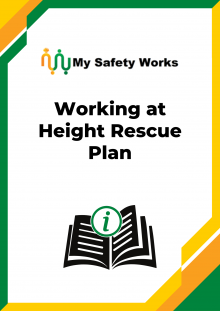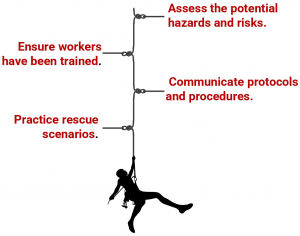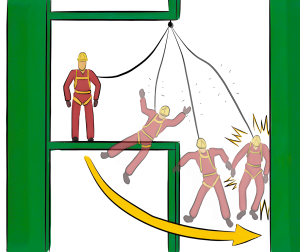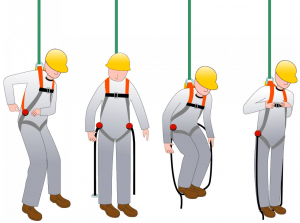
This working at height rescue plan package includes:
The rescue plan can provide you with a well-structured and organised approach to responding to a fall at a workplace and minimise the risk of an injury in the event of a fall from height.
A working at height rescue plan is a written document that outlines the procedures and precautions to be taken in case of an emergency situation where a worker becomes injured, incapacitated or trapped while working at height.
The rescue plan includes all the necessary information, equipment and the nominated personnel required to safely rescue a worker and prevent further injury or harm.

An effective working at height rescue plan should identify the following:
Note: Having a robust working at height rescue plan in place can help prevent incidents, ensure the safety of workers and minimise the potential for loss of life or injury.
Under the WHS Regulation section 80, a person conducting a business or undertaking (PCBU) who provides a fall arrest system as a control measure must establish emergency and rescue procedures. The rescue procedures must be tested to confirm they are effective.
In effect, the workers must be provided with suitable and adequate information, training and instruction in relation to the emergency procedures. Refer to the Code of Practice for Managing the Risk of Falls at Workplaces.
Developing a working at height rescue plan involves undertaking several key steps, inclusive of:
1. Identifying the hazards: Identify all potential hazards associated with working at height. This should be done by conducting a comprehensive risk assessment of the working area.

Be Aware of the Inertia Effect
2. Developing a rescue plan: Based on the identified hazards, develop a comprehensive rescue plan that outlines the procedures and equipment to be used in case of an emergency.
3. Selecting the right equipment: Select the right equipment based on the nature of the hazards and rescue scenarios identified in the rescue plan. Ensure that all equipment is maintained and inspected regularly.
4. Identifying and training rescue personnel: Identify and train personnel who will be responsible for executing the rescue plan. These individuals should be properly trained, experienced and qualified to execute the plan safely.
5. Developing communication protocols: Develop communication protocols and procedures for coordinating the rescue operation. These should include an emergency response plan, communication channels and instructions for calling for assistance.
6. Implementing and practicing the plan: Once the rescue plan has been developed, it should be implemented and practiced. All workers should be trained on the plan and should know their role in case of an emergency.
Having well-maintained and up-to-date rescue equipment is crucial for ensuring the safety of workers who are undertaking work height.
Training employees in the proper use of this equipment and establishing emergency response procedures are equally important to ensure a quick and efficient response in the event of a fall.

These devices are designed to be worn by workers at height and can be activated in case of a fall, allowing the worker to lower themselves safely to the ground or a lower level.
Some self-rescue devices have integrated descent mechanisms, while others may use controlled descent equipment. These devices are compact, lightweight and easy to use, providing workers with an added layer of protection and autonomy in the event of a fall.
Fall rescue kits and systems are comprehensive packages that include a variety of tools and equipment necessary for rescuing a worker who has fallen from height. These kits typically contain items such as harnesses, ropes, pulleys and descenders, along with detailed instructions on how to perform a successful rescue.
They are typically used by trained rescue teams or designated personnel responsible for responding to fall emergencies on worksites. Having a properly equipped rescue team and well-maintained rescue kits is critical for ensuring a quick and effective response in the event of a fall.
Tripods and winches are specialised fall rescue equipment used when the structure or terrain makes it challenging to perform a traditional rescue. The tripod acts as a stable anchor point, and the winch system allows for controlled raising or lowering of the fallen worker.
These tools are often employed in confined spaces or areas where traditional rescue methods may not be feasible. They require specific training and expertise to ensure proper setup and operation to execute safe and successful rescues.
Note: Regular inspections and maintenance of rescue equipment are essential to guarantee their reliability when needed most.
Suspension trauma is a condition that can occur when a person is suspended in a harness for an extended period of time. The weight of the person’s body compresses the veins in their legs, which prevents blood from returning to the heart. This can lead to a decrease in blood pressure, oxygen deprivation to the brain and eventually unconsciousness.

Using Suspension Trauma Straps
The symptoms of suspension trauma typically start after 10-20 minutes of suspension. They may include light-headedness, nausea, sweating, numbness in the legs and blurred vision.
There are several things that can be done to prevent suspension trauma. These include:
Note: Suspension trauma can be a serious condition that can be fatal. By following the safety tips above, you can help to prevent this from happening.
This rescue plan has provisions for the following aspects of an emergency rescue at height:

If you can find a better working at height rescue plan package at a cheaper price, we will REFUND YOU double the cost of this package.